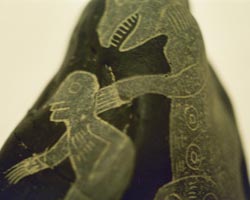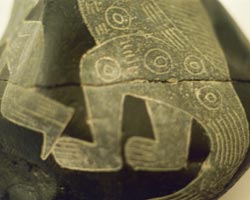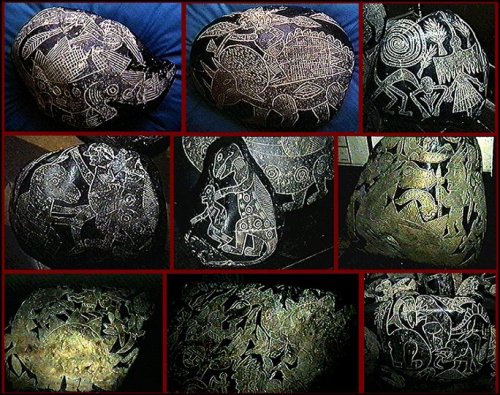Are Peru’s Ica Stones Safe?
Posted by: Loren Coleman on August 19th, 2007

Dinosaurs and men alive at the same time? I don’t really want to get into that discussion, but I want to alert you to the fact a “piece” of the evidence (pro or con) used by some to support their point of view in the debate, the Ica Stones, may be missing or damaged.
The Peruvian earthquake of August 15, 2007, has resulted in some worry for them. Ica, Peru, was one of the hardest hit areas. I reached people usually in contact with those who keep the Ica Stone safe and/or at the Ica Stone Museum. Here’s the message they created in response:

*Peru Quake Update*
August 19, 2007
Greetings,
On Wednesday, August 15, Peru sustained a massive 8.0-magnitude megathrust earthquake that rocked the southern coastal region near Ica, a city of 650,000 residents, killing hundreds, and leaving many feared trapped in the rubble. “We don’t have lights, water, and communications. Most houses have fallen. Churches, stores, hotels —everything is destroyed,” cried Pisco Mayor Juan Mendoza.
* * *
We have been unable to reach our friends, the family of Eugenia Cabrera (Ica Stone Museum), and have no word as to their safety or the condition of the Ica Stone Museum, but we will update all news on our website at www.labyrinthina.com. The situation in the Ica/Paracus/Pisco area has become desperate, and aid is needed IMMEDIATELY. Thousands have been left without homes and are currently sleeping in the streets. Problems such as a lack of food and water have worsened the situation. Everything is needed from cots to shovels, from wheelbarrows to water, from blood to blankets.
Please consider a cash donation to one of the many charitable relief organizations of your choice, or refer to the partial list of Peruvian agencies and personal grass root endeavors, [noted here].
May God Bless and Protect our many dear Friends in Peru.
With blessings,Kathy Doore, www.labyrinthina.com

The Ica Stones are a collection of andesite stones allegedly discovered in a cave near Ica, Peru. The Ica stones were popularized by Dr. Javier Cabrera, a Peruvian medical doctor who received an engraved stone as a birthday gift. In thirty-five years, he has collected over 15,000 engraved stones.
The stones show many things, from attacking dinosaurs to advanced technology, from maps to pornography.
But are they real? Tourist art? Gaffs? Or a record of ancient times?
In 1977, during the BBC documentary Pathway to the Gods, Basilio Uschuya produced a “genuine” Ica stone with a dentist’s drill and claimed to produce the patina by baking a stone in cow dung. In 1996, another BBC documentary was released with a skeptical analysis of the stones.
About ten years ago, the new attention to the Ica Stones prompted the authorities of Peru to arrest Basilio Uschuya.
Under Peruvian law, it is illegal to sell archaeological discoveries. Basilio recanted that he had found them and instead claimed that they were hoaxes he and his wife created. He was not punished, and continued to sell the stones to tourists as trinkets. He confirmed that he had forged them during an interview with Erich von Däniken, but recanted that claim during a later interview with a German journalist.
Spanish investigator Vicente Paris, after four years of investigation, offered in 1998 new evidence that supports that the stones are a hoax. Among the proofs presented by this investigator were microphotographs of the stones that showed traces of modern paints and sandpaper.
Whether real or fraud, their safety is important if further, modern analysis of the Ica Stones are to take place.

Replicas of a few of the Ica Stones.
About Loren Coleman
Loren Coleman is one of the world’s leading cryptozoologists, some say “the” leading living cryptozoologist. Certainly, he is acknowledged as the current living American researcher and writer who has most popularized cryptozoology in the late 20th and early 21st centuries.
Starting his fieldwork and investigations in 1960, after traveling and trekking extensively in pursuit of cryptozoological mysteries, Coleman began writing to share his experiences in 1969. An honorary member of Ivan T. Sanderson’s Society for the Investigation of the Unexplained in the 1970s, Coleman has been bestowed with similar honorary memberships of the North Idaho College Cryptozoology Club in 1983, and in subsequent years, that of the British Columbia Scientific Cryptozoology Club, CryptoSafari International, and other international organizations. He was also a Life Member and Benefactor of the International Society of Cryptozoology (now-defunct).
Loren Coleman’s daily blog, as a member of the Cryptomundo Team, served as an ongoing avenue of communication for the ever-growing body of cryptozoo news from 2005 through 2013. He returned as an infrequent contributor beginning Halloween week of 2015.
Coleman is the founder in 2003, and current director of the International Cryptozoology Museum in Portland, Maine.










The Ica stones are safe. I talked with Eugenia Cabrera in Ica after the earthquake. The museum sustained minor damage and some stones fell and cracked during quake. But all the stones are still there. We are currently having stones analyzed in blind tests at laboratories and universities. Previous tests at two labs, university and forensic crime lab showed evidence of antiquity. This is discussed in my book Secrets of the Ica Stones.
I am glad to hear that the stones are okay. I have read up, a little, concerning these stones. I will have to say that the sheer number of stones should point towards authenticity. Not too many people will work that hard for no return in today’s society. The stone that I first saw a picture of had a map of the world with an extra land mass in the Pacific ocean.
I have always found it interesting how it is that around the world, almost every society of the past, there are stories and even carved evidence of at least some dinosaurs surviving up to the point where someone took the time to somehow preserve his/her memory of them, and yet just because someone in Europe a few centuries ago made the claim that these creatures couldn’t have lived with humans that is who the whole world listens to, even the christian church with their record of at least one dino in Job 40:15, called behemoth. Most Bibles with notes in the margins will say that behemoth would be an elephant or hippo, even though the description does not come close. The reason for this is because when the Bible was translated into english for the first time, europeans had just wandered down into the heart of Africa and discovered that there are large animals down there. Size wise, the 2 sound similar.
The fact that one of the stones shows a Triceratops with Stegosaurus-style back plates (the second stone pictured) is a dead giveaway of a hoax.
The October 2001 Fortean Times article, “Jurassic library – The Ica Stones” by Filip Coppens goes into more detail about why the stones are hoaxes:
“The first-hand observation by Neil Steede that, even though the stones he examined did have this patina, there was no patina in the grooves. This suggests that while the stones were certainly very old, the carvings were clearly of far more recent origin”
“[Neil Steede] concluded that these “definitely genuine” stones show a finer workmanship and have less deep cuts than Cabrera’s stones. This is a clear indication of a more highly skilled manufacturer than Cabrera’s artisan. Furthermore, they are restricted to depicting conventional humans and existing animals, not extinct animals; nor do they include any examples of the more exotic motifs of the Cabrera stones.”
“…if humans existed that far back, how did they survive the several global cataclysms that contributed to the demise of the dinosaurs and huge percentages of other extant life-forms? If dinosaurs lived into the Modern Era, why did they suddenly disappear?” The fact that no fossils showing dinosaur remains that can be dated to a time when humans existed have been found and how no other cultures in South America make reference to dinosaurs both point to the stones being hoaxes.
Let’s not forget that Dr. Cabrera also had clay statues depicting dinosaurs that were similar to works made by Basilo Uschuya. Also, the statues were tested in the 90’s and found to be “relatively young” (as in they could’ve been made “20 years ago”) and that they still contained water.
Also, Mr. Uschuya made a custom Ica stone that said “BBC TV” on it for a man by the name of Ray Sutcliffe in 1977. I think that proves beyond a shadow of a doubt that he faked the Ica Stones.
Come to think of it, didn’t Irma Gutierrez de Aparcana help make some of the stones? I also thought I once read something about Basilo Uschuya hiring others to produce the stones.
Where can I find some images of known artwork from the area, I mean ancient pieces.
The Ica Stones are fine, I saw them a few months ago, quite a distance from Lima. (And, of course, local craftsmen are always making more…)
Not to mention the theropod on the stone below it, with the badly outdated upright stance…
U.T. Raptor:
Excellent point! Now that I think about it, its arms look too long…
I don’t know if the stones are faked or not but I do get tired of the “it doesn’t fit the evolutionary theory so it MUST be a fake” argument. I thought science was supposed to be openminded! I guess all the anomolies of spear points, shards, and other items found in strata millions of years old (by geological dating) and long before humans were supposed to have evolved must have been made by intelligent monkeys!
By the way, the human’s arms seemed too short. Must be a fake!!
HOOSIERHUNTER:
Humans and dinosaurs not coexisting has nothing to do with evolutionary theory; it’s because no solid evidence of coexistence has been found (such as a fossil of a carnivorous dinosaur with human remains-that have teeth marks matching the fossilized dinosaur teeth-in its stomach area).
On a related matter, we know from fossilized (complete) remains that the Tyrannosaurus Rex had short forelimbs with two-fingered claws (Note the amount shown on the stone) and that the Triceratops didn’t have back plates. This isn’t theory, this is fact. However, that’s not the only reason why the stones are believed to be fake.
The patina isn’t in the grooves of the stones like it should, the man who “found them” successfully recreated a stone for the BBC using the hoaxing methods he admitted to in a prior interview, he refused to show where the stones were “found” (which would allow for dating to be determined), and other “evidence” he found was shown to be of recent origin.
I admittedly haven’t heard about the shards that you’re referring to, but I suspect that talkorigins.org might have the answers you seek (a quick glance shows that they discuss an “anomolous” hammer and iron pot).
Just to note that Dennis Swift’s idea of ancient stops at about 6500 years ago as he is a Young Earth creationist.
Oh – I saw the BBC tv programme on this, and it looked at the stones showing a heart transplant and the magazine article they were clearly copied from.